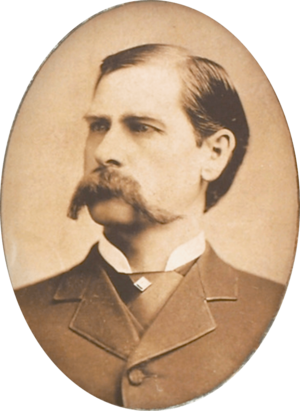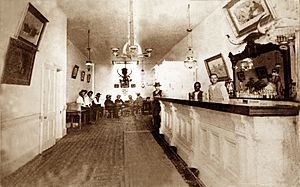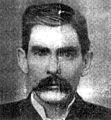Doc Holliday facts for kids
Quick facts for kids
Doc Holliday
|
|
|---|---|
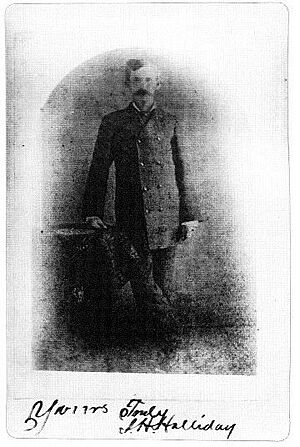
Autographed portrait, Prescott, Arizona, c. 1879
|
|
| Born |
John Henry Holliday
August 14, 1851 Griffin, Georgia, U.S.
|
| Died | November 8, 1887 (aged 36) |
| Resting place | Pioneer Cemetery (a.k.a. Linwood Cemetery), Glenwood Springs, Colorado, U.S. |
| Education | Pennsylvania College of Dental Surgery |
| Occupation | dentist, professional gambler, gunfighter |
| Known for | Gunfight at the O.K. Corral Earp Vendetta Ride |
| Spouse(s) |
"Big Nose" Kate Horony (common-law wife)
(m. 1877–1882) |
John Henry Holliday (born August 14, 1851 – died November 8, 1887), known as Doc Holliday, was an American dentist and gambler. He was a close friend of the famous lawman Wyatt Earp. Doc Holliday is most famous for his part in the Gunfight at the O.K. Corral in Tombstone, Arizona.
People often said he had killed many men. But history experts now believe he killed only a few. Doc Holliday's interesting life has been shown in many books and movies.
At age 20, Holliday became a dentist. He started his practice in Georgia. Soon after, he learned he had tuberculosis. This was the same illness that took his mother's life. Hoping a warmer climate would help, he moved to the American Southwest. There, he became a gambler.
He met Wyatt Earp in Texas. Holliday saved Earp's life during a fight. They became good friends. In 1879, he joined Earp in Las Vegas, New Mexico. Then they rode to Prescott, Arizona, and later to Tombstone.
In Tombstone, some outlaws called the Cochise County Cowboys caused trouble. On October 26, 1881, Holliday became a deputy. He joined the Earp brothers to disarm the Cowboys. This led to the famous shootout near the O.K. Corral.
After the shootout, Wyatt Earp's brothers were hurt or killed. Wyatt then deputized Holliday and others. They went after the outlaws they believed were responsible. They found and stopped one outlaw, Frank Stilwell. The local sheriff then wanted to arrest Holliday and others. But Wyatt Earp helped Holliday avoid being sent back to Arizona. Holliday spent his last years in Colorado. He died of tuberculosis at age 36.
Contents
Doc Holliday's Early Life and School
John Henry Holliday was born in Griffin, Georgia. His parents were Henry Burroughs Holliday and Alice Jane McKey Holliday. His family had roots in England and Scotland. His father fought in the Mexican-American War and the American Civil War. In 1864, his family moved to Valdosta, Georgia. His mother died there from tuberculosis in 1866.
Holliday went to the Valdosta Institute. He studied subjects like history, math, and languages. These included Latin, French, and Ancient Greek.
In 1870, Holliday moved to Philadelphia. On March 1, 1872, he earned his dental degree. He graduated from the Pennsylvania College of Dental Surgery. He was 20 years old at the time. The school held his degree until he turned 21. This was the age needed to practice dentistry.
Doc Holliday's Adult Life
Starting a Career
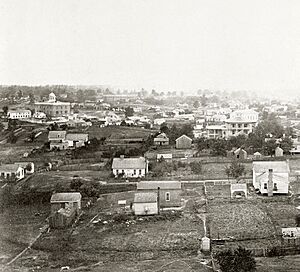
Holliday moved to St. Louis, Missouri. He worked as an assistant to a classmate. A few months later, he moved to Atlanta. He joined a dental practice there. He lived with his uncle and his family. He hoped to build his dental business.
Health Challenges
Soon after starting his dental practice, Holliday got tuberculosis. Doctors told him he had only a few months to live. But they said a drier, warmer climate might help. So, Holliday left for Dallas, Texas. This was a big city near the Western Frontier.
Life in Dallas
In Dallas, Holliday worked with another dentist. They won awards for their dental work. Their office was on Elm Street. But Holliday's coughing spells from tuberculosis made his dental practice slow down.
Holliday found he was good at gambling. It soon became his main way to earn money. He was arrested for illegal gambling in Dallas. He also had a gunfight with a saloon owner. No one was hurt, and he was found not guilty. He then moved his dental office to Denison, Texas. But after more trouble with gambling, he left the state.
Moving Westward
Holliday went to Denver, Colorado. He gambled in towns along the way. In 1875, he settled in Denver. He worked as a card dealer. He got into a fight with another gambler. Holliday left the man seriously hurt.
Holliday then heard about gold in Wyoming. He arrived in Cheyenne, Wyoming, in 1876. He worked as a dealer at a saloon. Later, he moved with the saloon to Deadwood, South Dakota. This was a gold rush town.
In 1877, Holliday returned to Cheyenne, then Denver. He also visited an aunt in Kansas. He then went to Breckenridge, Texas, to gamble. He got into a fight there and was hurt. His cousin came to help him recover.
After healing, Holliday moved to Fort Griffin, Texas. There, he met Mary Katharine Horony. She was a woman who worked in dance halls. She was the only woman Holliday is known to have had a relationship with.
Doc Holliday Meets Wyatt Earp
In 1877, outlaws robbed a railroad camp in Kansas. Wyatt Earp was a temporary deputy U.S. marshal. He went to Fort Griffin, Texas, looking for the outlaws. Earp met John Shanssey, a saloon owner. Shanssey told Earp to ask Doc Holliday. Holliday had played cards with the outlaw. Holliday told Earp where he thought the outlaw went.
Earp returned to Dodge City in 1878. He became the assistant city marshal. Holliday and Horony also arrived in Dodge City. They stayed at a boarding house. Holliday tried to practice dentistry again. He put an advertisement in the local newspaper.
One story says that some cowboys rode into Dodge City. They caused trouble at the Long Branch Saloon. Earp went to stop them. Many cowboys pointed guns at him. Holliday was playing cards nearby. He quickly drew his pistol and helped Earp. This saved Earp from a dangerous situation. Earp believed Holliday saved his life that day. The two men became close friends.
Moving to New Mexico
Holliday became known for his skill with a gun and cards. In late 1878, Holliday and Horony arrived in Las Vegas, New Mexico. The hot springs there were thought to help people with tuberculosis. Doc opened a dental practice and gambled. But the winter was very cold, and business was slow. The local government then banned gambling. Holliday was fined for gambling. The ban and cold weather made him return to Dodge City for a few months.
In September 1879, Wyatt Earp left Dodge City. He went to Arizona Territory. Holliday and Horony returned to Las Vegas. They met the Earps there again. The group then went to Prescott, Arizona Territory. Holliday stayed in Prescott for a while. He thought the gambling was better there. Holliday finally joined the Earps in Tombstone in September 1880. He soon became involved in the events leading to the Gunfight at the O.K. Corral.
Railroad Conflict
In Dodge City, Holliday joined a team led by Deputy U.S. Marshal Bat Masterson. Masterson was trying to stop a conflict between two railroad companies. They were fighting over a route through the Royal Gorge in Colorado. Holliday stayed there for about two and a half months. The government helped end the fighting. Holliday received some money and returned to Las Vegas.
Building a Saloon
The Santa Fe Railroad built tracks near Las Vegas, New Mexico. A new town grew up, and gambling was popular. In July 1879, Holliday was in a saloon. A man named Mike Gordon caused trouble. Gordon fired a shot at Holliday. Gordon died the next day. Holliday then paid to build "Doc Holliday's Saloon." He partnered with John Webb. While in town, he was fined for gambling and carrying a weapon.
Moving to Arizona Territory
Holliday and Horony seemed to be settling in Las Vegas. But then Wyatt Earp arrived in October 1879. He told Holliday about a silver boom in Tombstone, Arizona. Holliday and Horony joined Wyatt and his family. They left for Prescott, Arizona Territory. They arrived and met Wyatt's brother, Virgil Earp. Holliday stayed in Prescott for a while. He thought the gambling was better there. Holliday finally joined the Earps in Tombstone in September 1880. He quickly became involved in the local conflicts. These events led to the Gunfight at the O.K. Corral in October 1881.
Arriving in Colorado
On May 15, 1882, Holliday was arrested in Denver. He was wanted in Arizona for a killing. Wyatt Earp worried Holliday would not get a fair trial. Earp asked his friend Bat Masterson for help. Masterson was the chief of police in Trinidad, Colorado. Masterson helped arrange for Holliday's release.
Holliday's hearing was set for May 30. Masterson convinced the Colorado Governor, Frederick Walker Pitkin, to deny Arizona's request. Masterson argued that the arrest papers were faulty. He also said there was a Colorado warrant for Holliday. The governor agreed and refused to send Holliday back to Arizona.
Masterson took Holliday to Pueblo. Holliday was released on bond two weeks later. Holliday and Wyatt met again in June 1882. Wyatt had helped keep his friend from being charged with murder. Holliday saw Wyatt one last time in 1886. They met in a hotel lobby. Wyatt's wife described Holliday as very thin and coughing a lot.
Holliday spent his last years in Colorado. He struggled with the high altitude. He needed more and more medicine for his tuberculosis. His health and gambling skills got worse.
Doc Holliday's Final Days
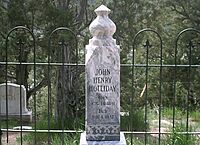
In 1887, Holliday was very sick and his hair was gray. He went to the Hotel Glenwood in Glenwood Springs, Colorado. He hoped the hot springs would help him. But the fumes might have harmed his lungs more. As he was dying, he reportedly asked for whiskey. When told no, he looked at his feet, which had no boots on. He supposedly said, "This is funny." He had always thought he would die in a gunfight, with his boots on.
Holliday died at 10 a.m. on November 8, 1887. He was 36 years old. Wyatt Earp did not hear about his death until two months later. His companion, Kate Horony, later said she was with him in his last days. He died from tuberculosis.
Memorial Service and Burial
A local newspaper reported that Holliday had been baptized Catholic. This was based on letters between Holliday and his cousin, a Catholic nun. But no official baptism record has been found.
Holliday's mother was a Methodist. She later joined a Presbyterian church. But she returned to Methodism before she died. She wanted her son to know her beliefs. Holliday himself once said he joined a Methodist church in Dallas. At the end of his life, Holliday became friends with a Catholic priest and a Presbyterian minister. When he died, the Presbyterian minister led his burial service. Many friends reportedly attended.
Holliday is buried in Linwood Cemetery in Glenwood Springs. Some people thought it would be hard to bury him there in November. The ground might have been frozen. But records show other people were buried there that same month. Newspapers at the time said Holliday was buried in Linwood Cemetery. But the exact spot of his grave is not known. Some claim his father had his body moved to Georgia. However, there is no official proof of this.
Doc Holliday's Public Image
Holliday had a strong personality. This helped him earn respect as a gambler. He was known as a skilled gunfighter. He once said he had been arrested 17 times. He also claimed five attempts were made to hang him.
His Character
Many people who knew Holliday described him as a calm, polite Southern gentleman. Wyatt Earp once said Holliday was a loyal friend. Earp called him a dentist who became a gambler. He was a gentleman made a wanderer by illness. Earp also said Holliday was the most skilled gambler and fastest, deadliest man with a gun he ever knew.
A newspaper once asked Holliday if his conscience bothered him. He reportedly said, "I coughed that up with my lungs, years ago."
Bat Masterson wrote that Holliday was quick to use his gun if he felt threatened.
Skills and Stories
Many stories about Holliday's violent reputation were just rumors. But he was very skilled at gambling and gunfights. His tuberculosis did not stop him from being a good gambler and a good shot. Holliday could use both hands well.
There are no old newspaper reports or legal papers proving many of the killings people said Holliday did. The only people he is known to have killed are Mike Gordon in 1879. He probably killed Frank McLaury and Tom McLaury in Tombstone. He might have killed Frank Stilwell in Tucson. And he killed William Allen in Colorado. Some experts think Holliday might have encouraged the stories about himself.
Photos of Doc Holliday
Doc Holliday's Legacy
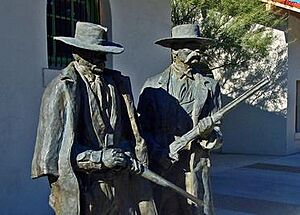
Doc Holliday is a very well-known figure from the American Old West. People remember him most for his friendship with Wyatt Earp. They also remember his part in the Gunfight at the O.K. Corral. Holliday's friendship with Earp has become a famous example of loyalty in American Western stories. He is often shown as a loyal friend and helper. He sticks with Wyatt through tough times, like the Gunfight at the O.K. Corral.
Together, Wyatt Earp and Doc Holliday have become symbols of loyalty and friendship.
A historical marker shows the home of Doc Holliday’s uncle in Fayetteville, Georgia.
Statues of Holliday and Earp were put up in Tucson, Arizona, in 2005. They stand at the place where Frank Stilwell was killed.
"Doc Holliday Days" are held every year in Griffin, Georgia, where he was born. Valdosta, Georgia, also held a Doc Holliday look-alike contest.
Tombstone, Arizona, also has an annual "Doc Holli-Days." This event celebrates the gunfighter-dentist. It includes gunfights, a parade, and a look-alike contest. Famous actors who played Doc Holliday in movies have been grand marshals at this event.
See also
 In Spanish: Doc Holliday para niños
In Spanish: Doc Holliday para niños



